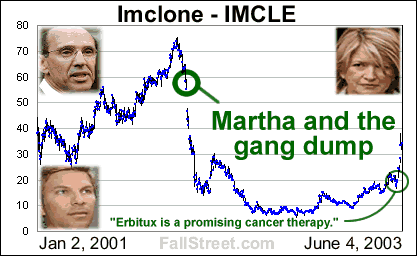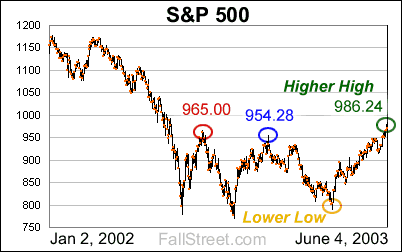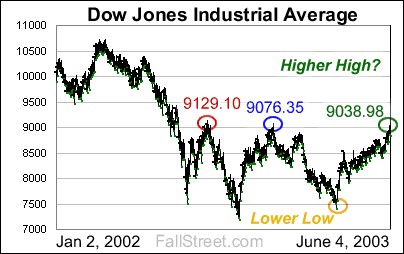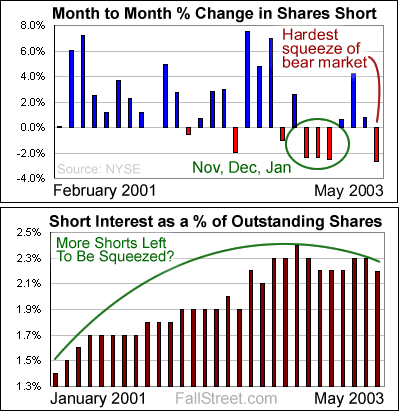June 5, 2003
Is Martha a Buy at Book?
Martha Is No Mickey
Whether it is Mickey Mouse, Winnie the Pooh, or Disney’s brand of sports entertainment (ESPN), the long term success/failure of the Walt Disney Company is predicated upon its brands. Such is why Disney stock has been rallying as of late; because the blockbuster movie ‘Finding Nemo’ is a new hot brand that the company may be able to leverage.
Martha Stewart Living (MSO) is really not that much different than a company like Disney. To be sure, whereas Winnie the Pooh pajamas fetch a higher price than No Name Bear pajamas, a Martha Stewart cookbook or magazine fetches a better price/ad revenues than just any ordinary publication.
However, there is a key difference between DIS and MSO that the investor should not overlook when attempting to value the two companies: MSO only has one brand…
MSO is a $4 Stock?
The company’s flagship magazine, Martha Stewart Living, has been published since 1991, and MSO stock has been publicly traded since October 22, 1999 (less than 5-years). Given this brief operating history it is difficult to draw any long term conclusions. Furthermore, given that former CEO and the company’s sole brandable force, Martha Stewart, has just been slapped with a 9-count criminal indictment, it is difficult to know whether or not MSO will be around in a few years time or it will go the way of the bankrupt WhiteRose.
This uncertain outlook aside, MSO has never been an attractive company when comparing its free cash flows to its stock price. Rather, MSO stock – until recently – has always seemed to be a little bit too far ahead of its underlying fundamentals such as FCF, earnings, and book.
In short, MSO is losing money and will likely continue to lose money and marketshare in the coming months. And while a few die hard Stewart fans are likely to stick with Martha under a worse case scenario, it is difficult to envision Martha sitting behind bars and her company thriving. Quite frankly, unless MSO’s stock price caves in below its book value there is no pressing need for the investor to even consider taking on the risk of owning the stock.
Using MSO’s $4.68 book value ($3.79 tangible book) and its roughly $5 million quarterly burn rate – which is difficult to forecast – shaving $10 million (2 quarters) off of equity seems reasonable (roughly $4.50 book). Throw in another 50 cents for shareholders running to exits and you get $4 a share. (MSO - Excel)
To note: MSO impairs intangibles (goodwill) annually.
Should Martha Be Behind Bars?
The NYSE comes out with a disciplinary report nearly every month, and each month there are numerous brokers/traders that are caught robbing shareholders of more money than Martha made out with on her ImClone sale. These criminals are usually given a fine, and not allowed to trade anymore – they take their leftover stolen money and mull things over for awhile in the Bahamas. The SEC comes out with similar reports on a regular basis, and, almost without exception, insider trading scams are not prosecuted to the full extent of the law.
Needless to say, Martha did not cause irrevocable damage to the investing public, and this is why there are conspiracy theories floating around about why she is facing such stiff charges (some say it is because she is a female playing a man’s game and others note that she was not a big political contributor).
But before calling Martha a victim, remember that Martha Stewart’s crime isn’t dumping nearly 4,000 shares of Imclone stock 1-day before a negative FDA announcement. Rather, her crime is lying about her reasons for the sale after the fact. At least Lay and company had enough common sense to plead the fifth. Think about it: would there be any charges against Stewart if she didn’t concoct a stop loss fable given that Waskal didn’t finger her and the sale could easily have been pawned off by a lawyer as coincidence before her broker tried to forge documents?
In sum, Martha did not have a $60 stop loss order. She sold her stock because she knew about the FDA result and/or Waskal’s attempted sales. As a former stock broker, Martha knew the rules of the game, and she broke them. Lock her up – delay her Bahamas retreat by a few years - and be sure to boot Grasso out and get to Lay and Skilling while you are it.
The perfect ending to the Martha saga would be her watching Imclone stock soar above $60 while she is sitting in the tank…
 |
Change the Rules to Benefit the Small Investor!
Here is a novel idea – rather than waste money and effort trying to bring down Martha, why not change the rules so that similar insider deals do not take place in the future?
To begin with, don’t allow the Martha Stewart’s to own stock in other companies: the price you pay for being a CEO is you only get to cheat, steal and lie to your own shareholders, not somebody else’s. To strict? How about forcing the Stewart’s to a 1-month lock up period after they announce their intention to sell stock? If this simple rule was in place the press release no one would have cared about would have read as follows: Martha Stewart files to sell 4,000 shares if Imclone dips below $60 a share.
But alas, simple solutions are not what the regulators – even if they are not crooked like Pitt – can get. Corporations, bankers, lobby groups, and/or Congressmen have been setting accounting and insider disclosure standards since 8 men met around the buttonwood.
Will the Dow Join The Crowd?
With the S&P 500 embarking upon a ‘lower lows and higher highs’ campaign (a bull market trend), and the Nasdaq in full mania rally mode, all that remains is the Dow.
 |
 |
9,000 was broken yesterday, and last years post July highs are within striking distance.
Liquidity Flows Strong
According to Thomson Financial (Reuters), companies issued more than $14 billion in convertible bonds in May, or 50% more than was issued in February 2000 (the month before the great bust). Convertbond tracks a similar type convert euphoria, with an estimated 101 deals year to date ($40.9 Bil) versus a total of 121 deals for all of last year ($54.9 Bil).
Oddly enough, while many point to the liquidity action in the markets as ‘bullish’, the action in convert market is a signal that many companies are desperate for capital. To be sure, while a bonus for a deal hungry Wall Street, converts are not a company’s first choice for funding. Those companies lining up to issue converts today – converts are higher up the food chain and usually better to own for the investor than stock – are setting themselves up for coupon payments and potential equity dilution in the future.
Incidentally, and even though many converts are off limits to the average investor, you should always know what converts, if any, a company has outstanding, and how the debt is structured within the company’s financials. For example, a tiny company called Counsel Corp has a convert due in October 31, 03 that is larger than the company’s market cap. You wouldn’t know that Counsel Corp is about to undertake a massive refinancing, or its stock is going to be heavily diluted, or the bond is going to default by looking solely at the financials -- the full extent of the upcoming damage is not laid out in the company’s balance sheet. (see rights to conversion and disclosure).
Short Interest for June Likely Down Again
After being mercilessly squeezed following the October 2002 bottom, short sellers were quick to jump back into the markets in February and March. However, following a series of ‘bullish’ events – good 1Q03 earnings, the toppling of Iraq, Greenspan’s anti-deflation push, and Bush’s tax plan -- shorts are now being squeezed even harder.
 |
Closing Remarks
Yes, the economic news this week has been promising, and it is likely that the US is embarking upon another period – however brief - of slightly better than awful growth. However, since the stock markets have been pricing in a turnaround during the entire market meltdown it is difficult to be bullish.
It is not Wall Street’s job to tell investors that stocks are overpriced. Rather, and in attempt to drum up new convert business and keep inflows moving into equity funds, Wall Street’s purpose – as it was during the 1990s – is to be bullish because bullish sells (trying to sell bearish over the last 3-years has not been a prosperous enterprise for the Street). Put simply, the only forecast to be made today is that the investor should expect the ‘buy the dips’ adage to be back in style soon…
Three months ago everyone was wondering whether or not the retail investor would ever move back into the markets. Today, with small investors slowly climbing back into the markets following every rally higher, everyone is wondering if short sellers will ever recapture the nerve they once had. Instead of worrying about liquidity trends and new bull market calls, perhaps what the investor should be wondering is whether or not a company like MSO – with its 50+% short interest (float) - is worth $4 a share. To be sure, the only ‘value’ type investment to be found in the current market is something that no one else wants and the short sellers feel comfortable shorting.
Unlike Mickey, Winnie, and Nemo, kids do not cry and pester their parents for Martha. Nevertheless, there a lot of fanatical ‘woman between the ages of 25 and 54 who owns her principal residence’ who live by what Martha says (as a brand Martha has historically demanded respect). If by a miracle Stewart is exonerated the Martha brand could be worth owning at the right price.
No one at FallStreet has an investment position in DIS or MSO.
All data and information within these pages is thought to be taken from reliable sources but there is no guarantee as such. All opinions expressed on this site are opinions and should not be regarded as investment advice.
Copyright © 2000-2003. FallStreet.com